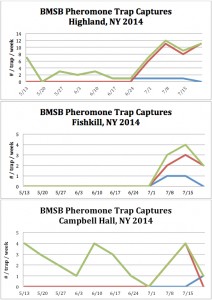The Brown Marmorated Stink Bug (BMSB) is being trapped in more then 15 sites throughout New York State with six sites in the mid and lower Hudson Valley.
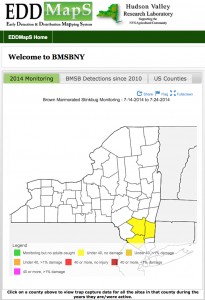
We strongly recommend that growers purchase and utilize BMSB Tedders traps this season, especially as we move into the development of the 2nd generation in late July. Coupled with scouting, trap placement along your orchards, bordering deciduous woodlands using duel #10 and MDT pheromone blend, will provide an important component in monitoring for this invasive and damaging pest on your farm. Populations are quite variable throughout the Hudson Valley with orchard BMSB captures ranging from single weekly captures to over 30 per week to date (see trap data below). Traps and lures can be obtained through this AgBio Link.
Our observations this season find the insect increasing in traps over the past week. Nymph movement to traps is on the rise. In Highland we’ve observed BMSB nymphs in Bartlett pears bordering hedgerows and woodlands with adults observed in peach, and adult feeding in Tomato (Milton, ENY Hort Team observation).
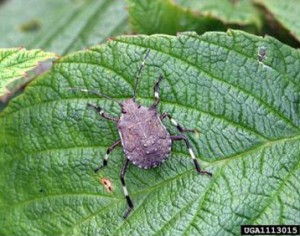
Data from the mid-Atlantic states (USDA-ARS WV) suggest the use of weekly trap captures above 40/week as a threshold for the beginning of BMSB management in locations where traps are used. Utilizing this threshold value, we are nearing trap threshold in Milton-East traps.
Generally, stink bug are a dry weather insect pest, looking for water and nutrients in well irrigated agricultural systems after primary deciduous tree and weed hosts dry out. As we continue through the season we are likely to see increased movement of the pest to orchards if we experience drought conditions. 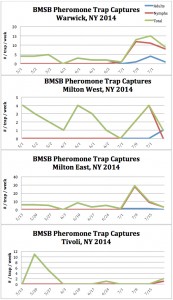
If you are trapping along the orchard edge, and not seeing BMSB in the orchard BUT are seeing them in traps, we would recommend NOT SPRAYING. Trap captures should be used to initiate intensive monitoring of the crop, spraying only on first find of BMSB in the crop.
If you are finding adults in the trees, we would recommend management with border sprays at first adult edge find.
Whole orchard applications should be made with the first nymph find prior to 1 August.
Growers should consider spraying Alternate Row Middle (ARM) after the 1st of August if adults are scouted in the orchard, making whole orchard applications once nymphs are found. Continued scouting through to harvest is recommended.
Late season tree fruit assessment in 2012* we found that the majority of late season injury appears to occur within the first 90′ of wooded edge, attributed at least in part, to 1st and 2nd generation adults moving to and from deciduous woodlands as they feed intensively feeding during acclimation to overwintering site finding.
The list of the most effective insecticides for BMSB management is found using this link. NYS labeled insecticides effective for use against the BMSB are available in four major classes including pre-mix formulations. Bifenthrin received an emergency exemption use permit (Section 18) to control brown marmorated stink bug (BMSB) on apples, peaches, and nectarines in Orange, Dutchess and Ulster Counties of NY. Products include Bifenthure and Brigade, showing the greatest degree of efficacy of the pyrethroid group.
Pyrethroid comparison:
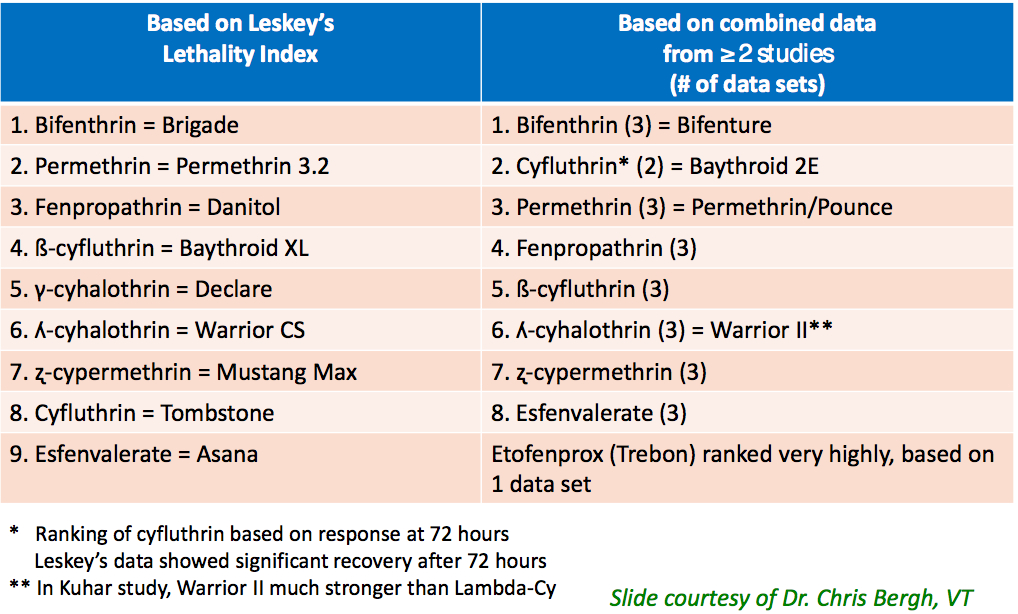


*We are nearing the time of year when the 5th instar BMSB molt into adults, and the adult will begin laying her eggs, giving rise to the second generation in late July / early August. However, when nymphs are found in the orchard in mid-July, it represents 1st generation populations residing in the orchard. These populations are damaging the fruit, although the injury will not be evident for two to three weeks. Nymphs will likely remain in the orchard to give rise to a second generation in early August. They need to be treated now while they are more susceptible (then adults) to insecticide applications. A whole orchard application should be made against the nymph populations if scouts are finding even a few in the block.
Adults in tree fruit this time of year however, often represent populations moving from deciduous woodlands to tree fruit, not necessarily residing in the crop. Overwintering females are still laying eggs this late into the season. If eggs are found in tree fruit, applications will need to be made upon hatch.

